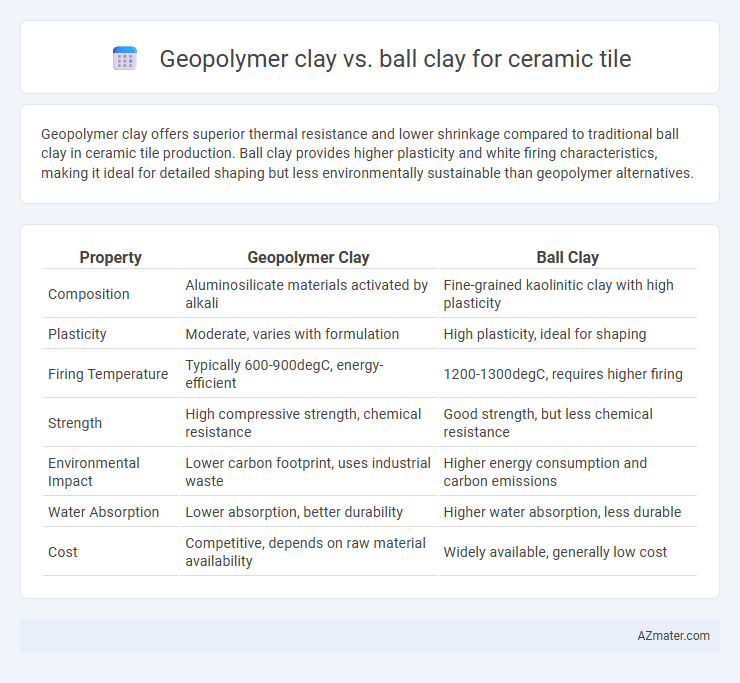Geopolymer clay offers superior thermal resistance and lower shrinkage compared to traditional ball clay in ceramic tile production. Ball clay provides higher plasticity and white firing characteristics, making it ideal for detailed shaping but less environmentally sustainable than geopolymer alternatives.
Table of Comparison
| Property | Geopolymer Clay | Ball Clay |
|---|---|---|
| Composition | Aluminosilicate materials activated by alkali | Fine-grained kaolinitic clay with high plasticity |
| Plasticity | Moderate, varies with formulation | High plasticity, ideal for shaping |
| Firing Temperature | Typically 600-900degC, energy-efficient | 1200-1300degC, requires higher firing |
| Strength | High compressive strength, chemical resistance | Good strength, but less chemical resistance |
| Environmental Impact | Lower carbon footprint, uses industrial waste | Higher energy consumption and carbon emissions |
| Water Absorption | Lower absorption, better durability | Higher water absorption, less durable |
| Cost | Competitive, depends on raw material availability | Widely available, generally low cost |
Introduction to Geopolymer Clay and Ball Clay
Geopolymer clay is an innovative, eco-friendly material derived from industrial by-products like fly ash and metakaolin, offering enhanced thermal resistance and mechanical strength for ceramic tile production. Ball clay, a naturally occurring fine-grained material rich in kaolinite, provides excellent plasticity and workability, making it a traditional choice in ceramic manufacturing. Understanding the distinct chemical composition and physical properties of geopolymer and ball clays is essential for optimizing tile performance and sustainability.
Composition Differences: Geopolymer vs Ball Clay
Geopolymer clay primarily consists of aluminosilicate materials activated by alkaline solutions, resulting in a synthetic inorganic polymer with high thermal stability and chemical resistance. Ball clay is a natural sedimentary clay composed mainly of kaolinite, mica, and quartz, characterized by its fine particle size, plasticity, and high bonding properties essential for shaping ceramic tiles. The fundamental composition difference lies in geopolymer's synthetic aluminosilicate matrix versus ball clay's natural mineralogical structure, influencing the fired tile's durability, porosity, and strength.
Processing Methods for Geopolymer and Ball Clay
Geopolymer clay for ceramic tiles undergoes a low-temperature curing process involving alkali activation, which promotes rapid polymerization and reduces energy consumption compared to traditional firing. Ball clay processing includes refining, deflocculation, and high-temperature firing, which enhances plasticity and strength but requires significant energy input. The distinct methods result in different microstructures, with geopolymer tiles exhibiting improved chemical resistance and lower carbon footprint than ball clay ceramics.
Performance in Ceramic Tile Manufacturing
Geopolymer clay offers enhanced thermal stability and superior chemical resistance compared to traditional ball clay, improving ceramic tile durability under high-temperature firing. Ball clay provides excellent plasticity and workability, facilitating shaping and forming processes but lacks the high mechanical strength and shrinkage control found in geopolymer clays. The incorporation of geopolymer clay in ceramic tile manufacturing results in tiles with improved fracture toughness and reduced porosity, contributing to longer-lasting, high-performance ceramic products.
Mechanical Properties Comparison
Geopolymer clay exhibits higher compressive strength and improved fracture toughness compared to ball clay, making it more suitable for high-performance ceramic tiles. Ball clay offers excellent plasticity and white firing characteristics but generally shows lower mechanical durability under stress. The enhanced mechanical properties of geopolymer clay result from its inorganic polymer matrix, which provides superior resistance to thermal and mechanical degradation in ceramic applications.
Environmental Impact and Sustainability
Geopolymer clay exhibits significantly lower carbon emissions compared to Ball clay due to its reliance on industrial by-products like fly ash or slag, reducing the need for energy-intensive processing. Ball clay extraction contributes to severe environmental degradation, including habitat disruption and water pollution, whereas geopolymer clays utilize waste materials that promote circular economy principles. The incorporation of geopolymer clay in ceramic tile manufacturing enhances sustainability by lowering raw material consumption and minimizing landfill waste, positioning it as an eco-friendly alternative.
Cost Analysis: Geopolymer Clay vs Ball Clay
Geopolymer clay offers a cost advantage over ball clay due to lower raw material extraction and processing expenses, resulting in reduced overall production costs for ceramic tiles. Ball clay involves higher mining and transportation costs along with more complex processing to achieve desired plasticity and strength, increasing the final tile cost. Lifecycle cost analysis shows geopolymer clay can enhance economic efficiency by minimizing energy consumption during firing and reducing environmental compliance expenditures.
Aesthetic Outcomes in Finished Tiles
Geopolymer clay offers enhanced aesthetic versatility in ceramic tiles due to its uniform particle size and improved plasticity, resulting in smoother textures and vibrant color retention compared to ball clay. Ball clay often imparts a more traditional, natural finish with a slightly creamy or off-white tone, but can cause minor surface irregularities affecting gloss and brightness. The controlled chemical composition of geopolymer clay allows for more consistent glaze application and sharper patterns, optimizing visual appeal in contemporary ceramic tile designs.
Limitations and Challenges in Usage
Geopolymer clay presents challenges such as higher curing temperatures and sensitivity to raw material variability, impacting consistency and scalability in ceramic tile production. Ball clay, while offering excellent plasticity and workability, tends to have higher impurity levels, which can cause firing defects and reduce tile strength. Both materials require precise processing controls to overcome these limitations and ensure high-quality, durable ceramic tiles.
Future Trends in Ceramic Tile Materials
Geopolymer clay offers enhanced sustainability and superior thermal resistance compared to traditional ball clay, aligning with the growing demand for eco-friendly ceramic tile materials. Advances in geopolymer technology enable lower carbon emissions during manufacturing, making it a key player in the future of green building materials. Research continues to improve the mechanical strength and durability of geopolymer clay, positioning it as a promising alternative for high-performance ceramic tiles.

Infographic: Geopolymer clay vs Ball clay for Ceramic tile
 azmater.com
azmater.com